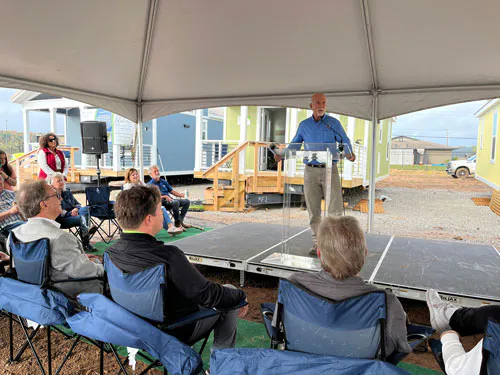Tulsa's 'Eden Village' Breaks Ground, Announces Plans for 3-D Printed Homes

Supporters of a new initiative to relieve homelessness broke ground Thursday on a planned 65-unit “tiny home” village, and announced the majority would be concrete “printed” homes.
It was a day that Brad Johnson, the Founder of Eden Village Tulsa, had long envisioned.
“Hopefully the community, which it needs to be a community deal, will get more involved and help make this a reality,” he said.

CEO Danny Stocksill said the first 10 homes are funded, and several businesses and foundations have set up matching donations through the end of the year.
The 17-acre site is just west of the Gilcrease Turnpike by the Arkansas River, on 61st West Avenue.
Tulsa’s “Eden Village” is modeled after new neighborhoods for the formerly homeless that started with a development in Springfield, Missouri.
Related: 'Eden Village' Homeless Outreach Makes Big Impact With Tiny Homes
Tulsa Chamber of Commerce members recently toured a similar development in Austin, Texas, where hundreds of homes are in development.
Related: Tulsa Leaders Head To Austin To Study City Challenges
One method for printing homes was recently featured on 60 Minutes.
At Tulsa’s Eden Village, the first of four traditional-style homes are on the site now, but the first residents won’t move in until next summer while more infrastructure is completed. Every resident will be someone who is homeless now, who will be qualified through an application process and supported once they move in with on-site services to ensure they can successfully transition back into permanent housing. The expectation is that residents will live out their lives in the community that is being created.
“This is not just a shelter and a roof; it's a way for homeless people to be good neighbors to each other,” said Abiding Harvest Church Pastor Chris Buskirk, “and for the community to have an interaction site where we can be good neighbors with people who were formerly homeless.”
The project will cost millions of dollars. The Helmerich Foundation is matching donations up to $1 million, until the end of the year.
Each home has a full kitchen, with a standard one-bedroom, one-bath, layout, each about 400 square feet. Johnson said it’s likely the majority of the homes will be printed because it’s faster, less expensive, and creates a more energy-efficient home.